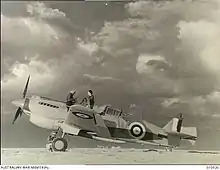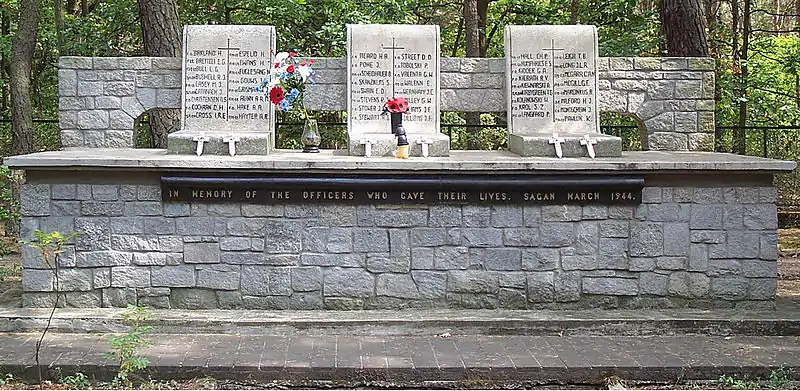Johannes Stephanus Gouws | |
|---|---|
| Birth name | Johannes Stephanus Gouws |
| Born | 13 August 1919 Bultfontein, Orange Free State, South Africa |
| Died | 29 March 1944 (aged 24) Munich area |
| Buried | Poznan Old Garrison Cemetery, Poland |
| Allegiance | |
| Service/ | |
| Years of service | 1940–44 |
| Rank | Lieutenant |
| Service number | 103275 |
| Unit | No. 41 Squadron SAAF, No. 40 Squadron SAAF |
| Battles/wars | World War II |
| Awards | Mentioned in Despatches |
Johannes Gouws (13 August 1919 – 29 March 1944), was a fighter pilot from South Africa who was taken prisoner during the Second World War. Notable for his part in the 'Great Escape' from Stalag Luft III in March 1944 when he almost reached Switzerland but was one of the men recaptured and subsequently murdered by the Gestapo.
Pre-war life
Gouws was born in Bultfontein, South Africa[1] the eldest son of an Afrikaans speaking farming family of Boer tradition. His boyhood ambition was to join the British South Africa Police. He was educated at the farm school and later Bultfontein High School where he was a keen athlete and captained the school rugby football team when it toured Cape Province in 1937.[2][3] He graduated from school that year and joined the Special Service Battalion a training unit for boys wishing to join the military. He applied for the South African Air Force but failed as his English language did not meet the required standard. Gouws returned to school, studied at University College of Orange Free State to study science and improved his language skills.[3][4]
Service career
Gouws was successful in his next attempt and joined the South African Air Force on 14 May 1940[5][6][2] as a pilot candidate and service number 103275. After completing basic training he learned to fly in South Africa in de Havilland Tiger Moth aircraft. He received his aircrew brevet “wings” and commission as second lieutenant on 29 March 1941. He was posted on 7 May 1941 to No. 41 Squadron SAAF flying Hawker Hartbees fighter bombers in Abyssinia.[7] On a ground attack mission on 18 August 1941 his aircraft developed a fuel leak and he had to crash land in a ploughed field,[8][5] the aircraft flipped over and his crewman had to fight to free Gouws from the wreckage. The local farmer assisted them for a reward and they returned safely.[6]

In September 1941 he was posted to No. 40 Squadron SAAF[2][6][7] which was then back in South Africa, the squadron's personnel were flown to Egypt to join the Desert Air Force. Until new aircraft arrived, the Squadron operated at Burg-el-Arab as an Advanced Maintenance Unit. In this period, six pilots were attached to No. 208 Squadron RAF for operational experience in modern monoplane fighters. The squadron became fully operational in March 1942, flying tactical reconnaissance missions and Photo Recce in support of British Eighth Army. The squadron's pilots soon learnt to operate in pairs and to stay out of range of small arms fire from the ground, to reduce heavy casualties; however, as Erwin Rommel's Afrika Korps prepared to go on the offensive, Luftwaffe Messerschmitt Bf 109 fighters concentrated on intercepting Tac.R aircraft. Casualties rose rapidly until HQ Desert Air Force ordered a fighter escort for all Tac.Rs.
Prisoner of war
One of the casualties was on 9 April 1942, a P-40 Tomahawk flown by Lieutenant Gouws on a mission over the Chichiba-Ezzeiat area was intercepted by two Bf 109’s and he was shot down[5] by Luftwaffe flying ace Gustav Rödel of Jagdgeschwader 27. Gouws belly-landed his aircraft on fire south of Mteifel Chebir and was taken prisoner.[9][10]

'Great Escape'
For the Great Escape operation Gouws was one of the team dispersing the excavated sandy earth[2] he was scheduled for an early position in the queue of men[10] to pass through the tunnel due to his active participation in the tunneling and fair command of the German language. Gouws was one of the first ten[11][12] of the 76 men who escaped the prison camp on the night of 24–25 March 1944, in the escape now famous as "The Great Escape". When the Germans discovered the escape they began extensive well planned manhunts. The plan of Gouws and his British born South African partner Rupert Stevens was apparently to head for Switzerland[2] via Breslau[13][14] They missed the train which they had hoped to catch at Sagan but travelled on a later train to Breslau[15] and later towards Switzerland on to Lindau where they were recaptured on 29 March 1944[16] near the Bodensee beside the border of neutral Switzerland.[14] on two different trains[17] The two South Africans were taken to Munich central Gestapo offices,[18] later that day they were apparently shot and cremated[19][20]
He was one of the 50 escapers executed and murdered by the Gestapo.[17][1][16] Originally cremated and buried at Sagan, he is now buried in part of the Poznan Old Garrison Cemetery.[21][22][2] His name is recorded on the official list published by the Royal Canadian Air Force[23]
His name was amongst the 47 murdered officers named in the British press when the story became public knowledge on or about 20 May 1944[24][25]

Awards
His conspicuous bravery was recognized by a Mention in Despatches as none of the other relevant decorations then available could be awarded posthumously. It was published in a supplement to the London Gazette on 8 June 1944.[26][7]
Other victims
The Gestapo executed a group of 50 of the recaptured prisoners representing almost all of the nationalities involved in the escape.
Post-war investigations saw a number of those guilty of the murders tracked down, arrested and tried for their crimes.[27][28][29]
| Nationalities of the 50 executed |
References
- Notes
- 1 2 Andrews (1976), p.205
- 1 2 3 4 5 6 Johannes Gouws [Biographical material - Johannes Gouws]
- 1 2 Vance (2000), p.127
- ↑ A Gallant Company - early life of Johannes Gouws
- 1 2 3 Read (2012), p.139
- 1 2 3 Vance (2000), p.128
- 1 2 3 SAAF Private Bag Pretoria, Service record – 103275 Johannes Gouws]
- ↑ A Gallant Company - Johannes Gouws - 41 Squadron
- ↑ Shores (1969), p.105
- 1 2 Vance (2000), p.129
- ↑ Andrews (1976), p.46
- ↑ Vance (2000), p.220
- ↑ Burgess (1990), p.248
- 1 2 Andrews (1976), p.51
- ↑ Vance (2000), p.228
- 1 2 Burgess (1990), p.271
- 1 2 Read (2012), p.143
- ↑ Vance (2000), p.257
- ↑ Andrews (1976), p.114-121 and p.196
- ↑ Read (2012), p.145 and 151
- ↑ Commonwealth War Graves Commission casualty – Lieut. J S Gouws SAAF
- ↑ Pegasus Archive - 50 murdered escapers
- ↑ RCAF Website with list of the 50 murdered officers
- ↑ Western Morning News, Dundee Courier and Yorkshire Post, 20 May 1944
- ↑ Ottawa Journal, 20 May 1944, p.17 – listing murdered officers
- ↑ "No. 36544". The London Gazette (Supplement). 2 June 1944. pp. 2645–2646.
- ↑ Vance (2000), p.209-210
- ↑ Andrews (1976), p.217-220
- ↑ Read (2012), p.288
- Bibliography
- Ted Barris (2014). The Great Escape. Dundurn Publishing. ISBN 978-1459728448.
- Simon Read (2012). Human Game. Constable. ISBN 978-1-4721-1262-0.
- Sean Feast (2015). The Last of the 39-ers. Grub Street. ISBN 978-1909166158.
- Jonathan F Vance (2000). A Gallant Company. Pacifica Military. ISBN 978-0-935-55347-5.
- Christopher Shores (1969). Fighters Over The Desert. Neville Spearman. ISBN 0668020709.
- William Ash; Brendan Foley (2005). Under the Wire: The Wartime Memoir of a Spitfire Pilot, Legendary Escape Artist and 'cooler King'. Bantam. ISBN 978-0-593-05408-6.
- Paul Brickhill (2004). The Great Escape. W.W. Norton & Company. ISBN 978-0-393-32579-9.
- Alan Burgess (1990). The Longest Tunnel: The True Story of World War II's Great Escape. Naval Institute Press. ISBN 978-1-59114-097-9.
- Albert P. Clark (2005). 33 Months as a POW in Stalag Luft III: A World War II Airman Tells His Story. Fulcrum Pub. ISBN 978-1-55591-536-0.
- Arthur A. Durand (1 January 1989). Stalag Luft III: The Secret Story. Patrick Stephens Limited. ISBN 978-1-85260-248-2.
- Allen Andrews (1976). Exemplary Justice. Harrap. ISBN 0-245-52775-3.
External links
- Project Lessons from the Great Escape (Stalag Luft III), by Mark Kozak-Holland. The prisoners formally structured their work as a project. This book analyses their efforts using modern project management methods.